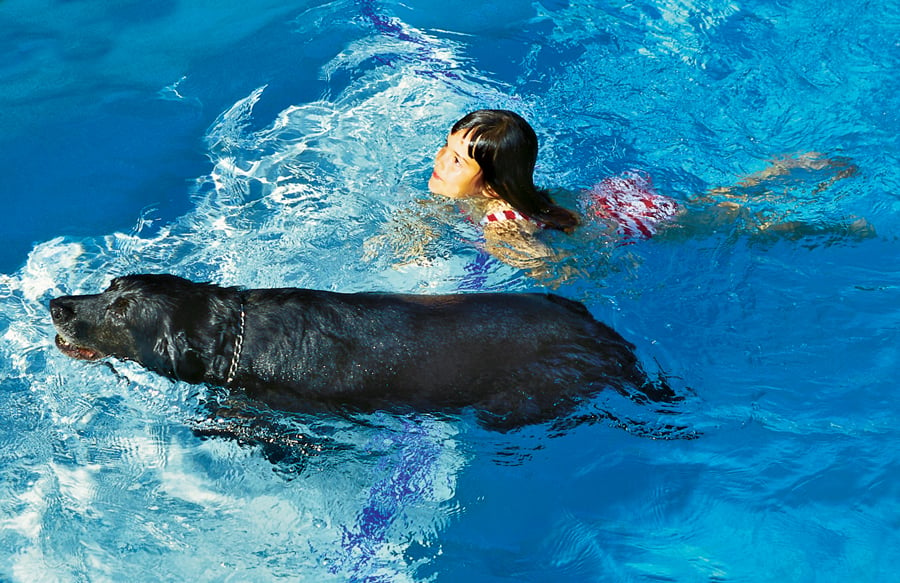—Benefits and misconceptions about automatic chlorine systems

—Updated July 3, 2025
Are you considering a “saltwater pool”?
For several decades, some homeowners have turned to this swimming pool sanitation technology that uses electrolysis to transform dissolved salt into chlorine gas.
Along the way, saltwater chlorine pools—also called saline pools—have gained a certain cache. Some homeowners even boast about owning one.
At the same time, other pool owners have faced unexpected problems and regret their decision to go salty.
While these systems provide a way to sanitize pools without the typical chlorine risks and other desirable advantages, some of the shine has already worn off.
Salt sanitizers offer a way to bypass traditional tablet, powder, and liquid chlorine.
Today, you also have several alternatives to regular chlorine for healthier pool water that use bare amounts of chlorine, including ozonation and advanced oxidation process (AOP).
Which approach is right for your pool?
If you think a saltwater chlorine system might be the answer to reducing your family’s (and pet’s) exposure to pool chemicals, you should know the basics of how this technology works—along with its benefits and potential drawbacks.
Saltwater misconception
The first point about saltwater pools is one that’s often overlooked: Saltwater pools are chlorinated.
Again: Saltwater pools are chlorinated.
Because you don’t physically add off-the-shelf chlorine to a saltwater pool, a common misconception is that it’s “chlorine-free.” This is simply not true.
Now, what is different from a traditionally chlorinated pool is how the chemical finds its way into the pool water and what happens to it later.
Let’s take a look at how.

Releasing chlorine from salt
The salt-chlorination process starts by adding several hundred pounds of salt into the pool. Once in the water, the salt dissolves, releasing ions of sodium chloride.
This pool water flows into the pool equipment where the salt chlorine generator operates.
Inside the generator’s chamber are several electrically charged titanium plates. These plates comprise what’s called the “salt cell.”
The electrical charges from the salt cell interact with the sodium chloride ions, separating the chlorine from them.
Now, they have transformed into the active, pure form of chlorine gas (Cl2) and the byproduct, sodium hydroxide.
This “free available” chlorine in the water performs sanitizing duties just like its tablet, powder, or liquid cousins. The chemical combines with organic contaminants in the pool water and efficiently destroys them.
After the chlorine does its work, the process repeats. It will do so as long as the generator and the pool pump are turned on and as long as sufficient salt remains in the pool.
The target for a salt pool is 2700 to 3400 parts per million (ppm) of salt. 3200 ppm is ideal. This amounts to roughly one-tenth the average salinity found in the ocean and to similar to the chemistry inside the human body.
Most backyard pools range in size from 10,000 to 20,000 gallons. So, you can also picture the salt level by imagining about 200 pounds per 10,000 gallons of water.

More salt please...
Once the pool water is salted and the chlorine generation system is up and running, you only need to add replacement salt occasionally.
Saltwater chlorine generators are designed for setting specific output levels. Adjustments are needed since various factors impact a pool’s chlorine needs.
For example, under strong sunlight, chlorine dissipates faster. Therefore, more of the chemical is called for.
The same is true for a pool party. A dozen swimmers will create a heavy bather load of organic contaminants, driving up disinfection requirements.
In cases like these, you will need to dial up the system’s output level to produce more chlorine.
On the other hand, during winter, when sunshine is limited and the pool sees little to no use, the demand is usually minimal.
Keep in mind that when the weather dips below 60 degrees, the system will still cease producing chlorine.
On-site chlorine-generation benefits
The advantages of a miniature chlorine factory at your home begin with convenience. In some aspects, a saltwater pool is easier to own and operate.
Above all, saltwater pool owners never need to buy, transport, or store the liquid, powder, or tablet form of the chemical. And they don’t have to handle the caustic agent either. In effect, the pool chlorinates itself.
Another reason for the rise in saltwater pool popularity is the overall swimming experience.
Hands down, swimming in a saltwater pool is more pleasant than one with traditional tablet, powder, or liquid chlorine. Owners of salt-chlorine systems often tout the silky and buoyant feel of the pool water.
Being in a saltwater pool is more enjoyable in other ways too.
Compared to traditionally chlorinated water, the swimming environment is not as harsh on eyes, skin, hair, nasal passages, and lungs.
The reason: Off-the-shelf chlorine is prone to creating byproducts—nasty compounds that are the culprits behind the dry hair, and irritated skin and eyes and awful odors.

When salt stings…
Saltwater chlorine generation also has its drawbacks.
First and foremost, a saltwater pool is not a silver bullet for people who are sensitive or allergic to chlorine.
Since they are swimming in chlorinated water, those with these susceptibilities to the chemical may face the same risks in a saltwater pool as in a traditionally chlorinated one.
If your goal is to reduce chlorine exposure, many experts say an approach that’s smarter is an ozone generator or AOP system.
These systems perform the heavy lifting disinfection duties and ensure fresh, healthy pool water with just trace amounts of chlorine.
Because their disinfection is faster and more powerful than chlorine, these treatment methods also win battles that chlorine can’t, such as preventing swimming pool “Crypto” attacks by this nasty, diarrhea-causing parasite.
Bear in mind, even if chlorine exposure does not concern you, some other saltwater pool challenges may.
In a broad sense, one problem comes down to perception: Mostly in the past, saltwater systems were incorrectly hyped as being maintenance-free.
In fact, there is no such thing as a maintenance-free body of water, and a saltwater pool is no exception. Like all pools, they require proper filtration, ongoing cleaning, and managing water chemistry—including weekly water testing.
Just like a conventionally chlorinated pool, saltwater-chlorine pools require “shocking.”
When chlorine demands rise, such as after a big pool party or heavy rain, a shock may be needed. This process involves adding extra chlorine or other chemicals to boost the level of "free chlorine.”
Saltwater pools are also prone to pH levels dropping too low. This comes as a result of acidic compounds created as byproducts of the electrolysis process.
To bring pH up, you will need to add sodium carbonate (soda ash)—just like you would with a regular chlorine pool.
Due to a high concentration of free chlorine, a saltwater pool can also become too acidic. If so, the water chemistry can etch the pool’s interior plaster finish (especially if it’s marcite—vs. quartz or pebble).
In addition, the nature of saltwater itself presents challenges. Specifically, salt is corrosive.
For that reason, whether the salt is in the water that’s inside the pool or contained in water that splashes out, it poses risks.

For example, stainless steel rails, ladders, the heater, and some light rings can fall prey to salt’s inherent corrosivity.
For this reason, experts recommend installing what’s known as a sacrificial anode. It helps prevent salt from attacking the pool heater and other metal components in and around the pool.
Outside the pool, salt can create other issues.
Over time, salt that builds up from repeated splash out will erode or damage a number of materials and items used in and around the pool, as well as certain kinds of decking.
Most rock waterfalls and pool grottos are susceptible. Typically, the type of natural stone used to build these lovely masonry features are porous.
That means salty water running down the rocks—as well as from splash out—can find its way into the tiny spaces in the stone. When it does, the salt slowly discolors and eats away at the exposed surfaces.
Salt may intrude into any accent boulders along the pool perimeter, the stone coping that borders the pool, and any stone covering a raised spa’s spillway or dam wall.
Simple rinsing and cleaning of these areas and features can go a long way toward preventing damage. However, over time, exposure to saltwater almost inevitably produces less-than-pleasing visible effects.
Saltwater is no friend of natural stone decks either. The porous surfaces of slate, flagstone, sandstone, limestone, quartzite, and travertine are vulnerable.
When repeatedly exposed to salty splatters or puddles, these stone surfaces will deteriorate at varying rates. Sections of deck worn by high-traffic patterns are at the highest risk.
Salt-laden pool water can harm wooden decks too. (Ditto for some wooden deck furniture and architectural columns.)
While its impact is less severe than ocean water producing “furry” surfaces on wooden piers, the pool’s wood deck planks will face some creeping deterioration and staining.
Now, for stone and wood, special sealants are available. Applied periodically, these products help prevent the salty water from seeping into the material and eating away at it. However, the presence of salt will require more frequent re-application of these products.
It’s worth noting that you have alternative design and building materials: There are excellent options for other deck materials that are more resistant to saltwater exposure.
Many homeowners opt for concrete decks with decorative finishes, patterns, and colorful acrylic toppings.
Concrete paver stones in a variety of patterns and colors are also a favorite for pool patios and backyard living areas.
Some species of wood are naturally waterproof, and a few—such as teak and Ipe (aka Brazilian Walnut)—are used for decks in some custom projects.
Before going the salt water route, integrating landscaping around your pool is another consideration.
Will your pool’s design incorporate planter boxes or landscape pockets? Want lush greenery close to your pool? How about using a grass lawn as your pool deck?

Beware: Repeat pool splash out can increase salinity and pH levels in the soil. That can harm or even kill grass, shrubs, and flowers.
The lesson here: Understanding the vulnerability of most natural stone, wood, and nearby landscaping should inform your pool-design process.
When planning or remodeling a pool and deck, ask questions, and proceed carefully.
Strategically consider your desired materials for your pool and deck. And evaluate how closely you want to incorporate landscaping into the pool’s configuration.
Depending on your favorite materials and design elements, bypassing the salt-chlorine approach may be your best choice.
Doing so makes sense if saltwater could threaten the long-term appearance of your pool, deck, and landscape.
It makes even more sense when you have other excellent options—ozonation and AOP—to ensure safe, swim-ready water with a minuscule chlorine level.
Maintaining your salt-chlorine system
If you still long for a saltwater pool, know that you will need to perform some maintenance for the chlorine generation process to work. The good news is that the tasks are simple and infrequent.
Periodically, you will need to add salt. Your unit will alert you when it’s time to pour more into the water.
However, a chlorine generator’s sensor can be off and give a bad reading on salt levels. For this reason, it’s a good idea to check salt levels monthly with a manual test.

In terms of the chlorine generator itself, most models are self-cleaning; they reverse the polarity in the cell to dissolve any scale.
But occasionally, it’s still important to visually inspect the cell for calcium build-up. If water in your area is “hard” with high calcium levels, or if your pool is often chemically out of whack, your system could fall victim to scale.
In these cases, the generator’s self-cleaning action won’t be able to keep up. Should this happen, you can use a mile acid solution to dissolve the mineral build-up.
Again, managing chemistry remains necessary with saltwater-chlorinated pools. Weekly water testing is vital to check levels of chlorine, pH, calcium, and total alkalinity and then treating the water to adjust.
Maintaining proper levels of cyanuric acid is also still required. With saltwater-generated chlorine, a pool typically requires higher amounts of this chemical than a pool with liquid, powder, or tablet chlorine.
Saltwater pools also require a much higher degree of vigilance to maintain proper pH levels.
Due to the byproducts created during electrolysis, and the alkaline nature of the salt itself, balancing pH can be a constant struggle.
Not having to buy chlorine will save you money. However, some of these savings may be offset since you will be buying more muriatic acid and cyanuric acid.
Over time, you will need to replace the system’s salt cell when the metal coating deteriorates and the electrolytic conversion process no longer works.
The replacement cell price tag can run as high as one-half the original system’s cost.
Exploring alternative pool sanitizer options

Saltwater-chlorinated pools continue to appeal to current and prospective pool owners.
Despite some of the system’s shortfalls—as well as the proven efficacy and safety of virtually chlorine-free options such as ozone and AOP—a saltwater pool remains an alluring concept to many.
Furthermore, thousands of saltwater owners absolutely love their water. They would insist on using the same chlorine-generation system on their next pool too.
Understanding some of the nuanced aspects of these systems and how they operate will help you decide.
Along with your pool builder, consider whether one is right for your family, lifestyle, and choices for pool and deck materials and landscaping.




.jpg?width=1490&name=rock-waterfall-slide-pool%20(1).jpg)